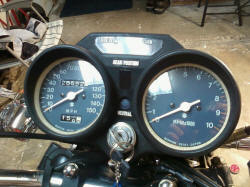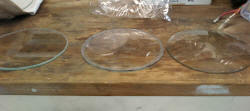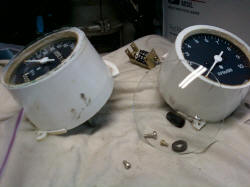The MOTO-DUDE DOMAIN
1975 GT380 - Repair and restoration log
|
I bought this bike in good shape off eBay
from a guy in 2007. This GT380 is the same year model and color as the bike
I owned in 1976. I also bought a non-running 380 (74 model, I think) from a
local guy, to use as a parts bike. I swapped a few parts onto the running
380 to help it cosmetically, including a '76 model front fender (I like the
fender with one stay as opposed to the original with two stays). Some
of the parts were sold on eBay to cover the cost of buying the bike.
I rode the 380 off
and on for about a year, when gas started appearing out of the overflow
drains on one of the carbs. I pulled the carbs, cleaned them, and put in a
Keyster kit, and adjusted the float levels (badly).
After a few tries, I got
the carbs to stop leaking, but the bike would not start. After checking, the
points cam was not turning, and it seemed the nylon gear had fractured. I
replaced the gear, and put the clutch cover back on with the timing marks
aligned, but did not get around to test running the bike or seeing if it
would fire up. It went on my "List of things to do".... and stayed there for
two years.
Finally, the guilt and
shame overcame my laziness and I started back on the bike. My first move was
to determine if the two cables laying across the seat were off the 380, or I
had simply laid them there and they belonged to another bike. I posted a
query (the first of many) on the
Yahoo Suzuki GT Triples forum, and my education, and the bike's
restoration began. |
July 2, 2010 --
POST ONE: A Tale of Two Cables, or how I plan to resurrect my '75 GT380
My 380 has the throttle cable splitter with TWO cables coming
out of the splitter
(my '73 or 74 380 parts bike has FOUR, see below)
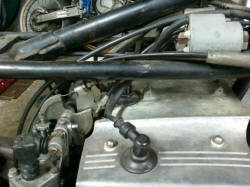
Two cables |
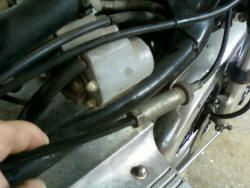
Another angle |
I see the one cable goes to the oil pump, and further back is
the tach cable.

|
This is my 1974 (or '73) GT380 parts bike, it has four cables
coming out of the splitter....
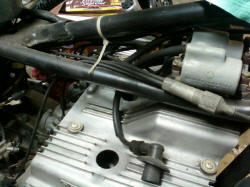
|

Oil Injector pump - bleeding and checking for bubbles. |
Removing the oil pump -
be careful not to lose the small
drive pin.
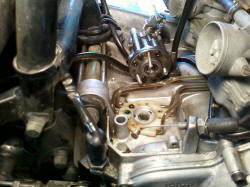
To take it out you take out the three Phillips screws in the
LOWER
flange and lift straight up. The pin I referred to is in the shaft below
the pump body. It is just slid into a hole in the shaft, and easily
falls out when you turn the pump on it's side. If you don't watch for
it, it's easy to lose, and then the pump doesn't get driven, and so no
oil to the bearings and cylinders = bad things happen. |
Someone else mentioned that the o rings that seal the pump bottom flange
discharge holes to the top of the distribution manifold (the plastic
tube thing) have a tendency to stick to the bottom of the pump. You
don't want to lose those either.
I put a pistol oiler to the input holes in the distribution manifold and
force 2 stroke oil out through the tubing. Use a different color oil
than you have in the lines and you can see the tubes change color. Then,
when you put the pump back and start the engine, you can watch the oil
tubing change color back to whatever is in the tank, and confirm the
pump is working.
Don't get carried away and pump a lot of oil through into the engine.
It'll smoke quite a bit with just part of a squirt through each of the
tubes.
Gordon
|
Purging air from the injector lines.
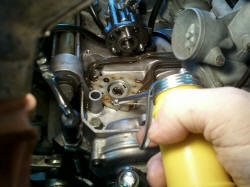
I used a dab of grease on the pin to help it
stay in place as I moved the oil pump back in place. |
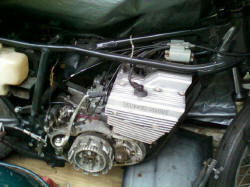
Part bike |
|
|
|
July 2010
Setting the timing and points
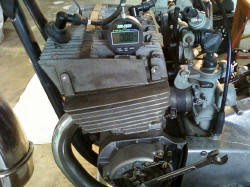
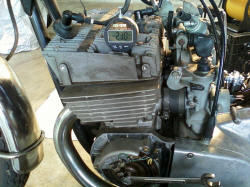

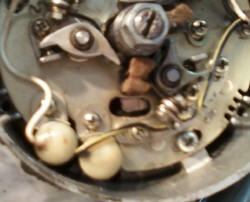
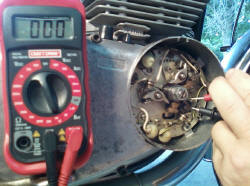
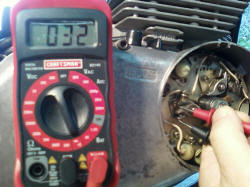
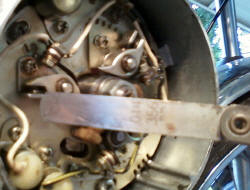
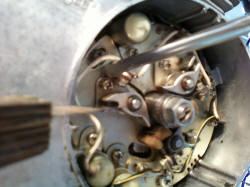
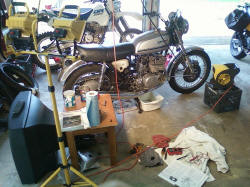
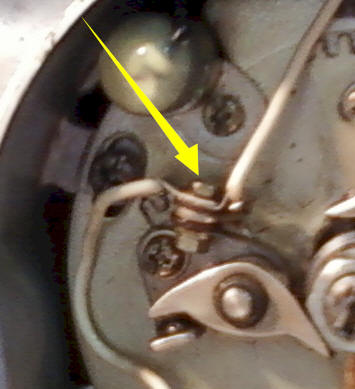
 Running
again video
Running
again video
July 18, 2010
But the tachometer was not turning, and the
experts tell me this is a sign that the small shaft that turns the
tach drive is not working properly, and this
shaft also turns... the oil pump!
July 20, 2010 - Pulled the tach drive, looks ok.
Something is definitely wrong with the oil pump shaft.
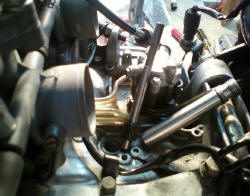
Pulled the clutch cover (again).
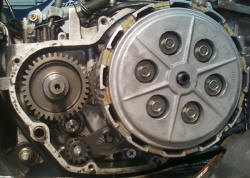
This is what I found... see the small gear at the bottom... well, that's the
end of the shifter it's on. I may as well have hung it on the turn signal.
Not sure how I missed this, guess I was in a hurry. |
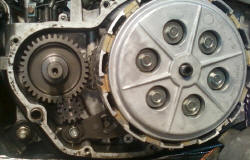
This is the proper place for the gear. Now it will turn the oil pump shaft
and tach. There is a small pin that goes crossways in the shaft and connects
the gear and shaft. Same part number and part as the pin in the oil pump
mentioned above. |
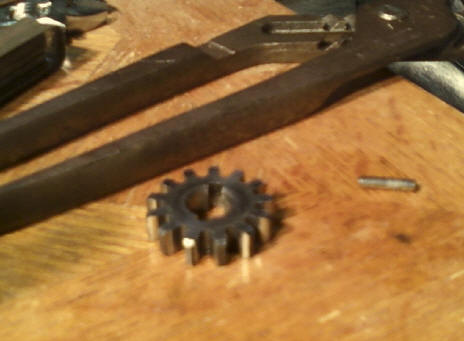 |
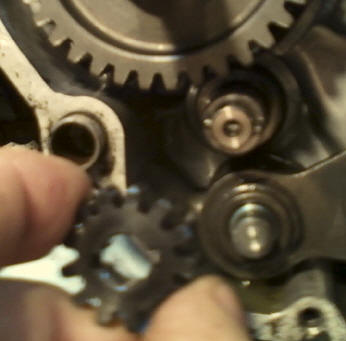 |

The proper fitment. |
|
After putting it together, it ran and the oil
pump and tach are working. But I FUBARed the kickstarter spring mechanism and
the kickstarter
drooped down by the footpeg like a Harley rider in need of Viagra.
So, off comes the clutch cover (again).
Aligned the timing marks on the crank, aligned
the L mark on the timing plate, put it back together and added oil. She runs,
kickstarter works, and it's getting oil. But it's clear
that the carbs are out of adjustment.
Next: clean the carbs and the petcock, to ensure
good fuel flow.
Carb
Inspection post.
July 31, 2010
After putting the carbs back on, the bike would
run, but not idle well--it wanted to rev up to 5000rpm when the clutch was
pulled in or it was in neutral. I decided that the starter circuit (choke)
must be leaking, so off come the carbs again.
August 2, 2010
I managed to ride the bike to a state inspection
center to get the sticker and get a Vehicle ID Certification, in order to
transfer the out of
state title and get a license plate.

At Jiffy Lube for the VIN certification
and inspection sticker. |
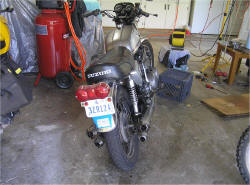
Success! Street legal after 3 years. |
Cleaning the starter plunger seat and
adjusting the slides.
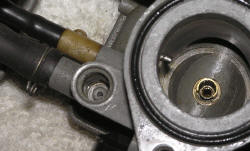
The starter plunger seat. |
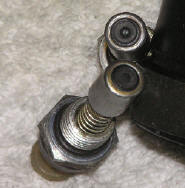
Starter plungers, hard to get now. |
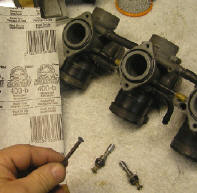
Per Mike, I suplerglued a bit of 400 sandpaper on a dowel and then polished
the plunger seats, followed by some cleaning spray and compressed air. |
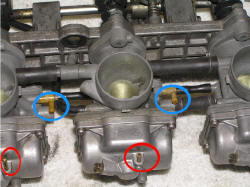
Both of these fittings are vents and should be left open to atmosphere. |
August 3, 2010
After putting the carbs back on, the bike began to
run much better. It idles smoothly at 1300rpm and accelerates well. It does not
respond crisply below 3000rpm, so I will put the stock
airbox back on and see if that helps. I put the oil pump cover, Ram Air
Induction cowling, and side panels back on and gave the bike a 70 mile road
test. She came through with flying colors.
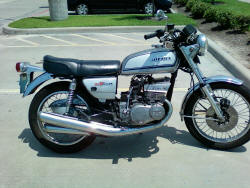 |
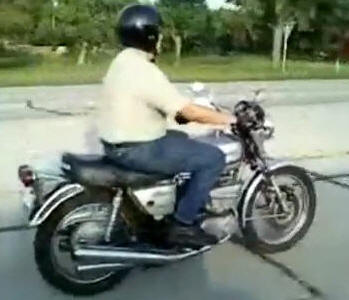
Video: Test ride with my friend Jesse. |
|
|
August 5, 2010 - New petcock
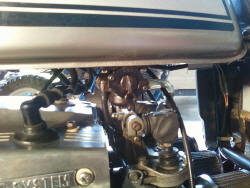
New petcock |
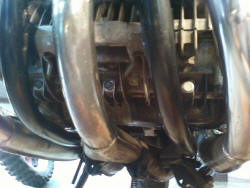
Inspecting the SRIS system... there doesn't appear to be one. |
August 6, 2010 - replacing the
clutch cable
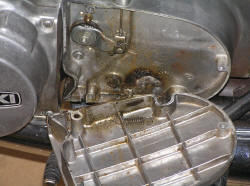
Well, well, pulled off the left trans cover and looked what surprises
awaited me-- spring was laying on the bottom... |
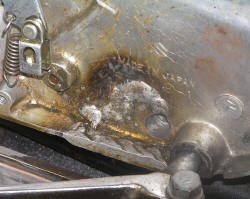
Looks like this area saw some welding repairs... |
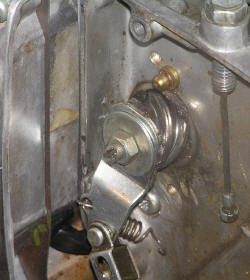
And I don't like the way this looks. |
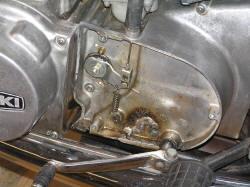
New clutch cable on, spring replaced. I'm leaving the shaft alone for now,
it works. |
August 13, 2010:
Time to polish all the aluminum.
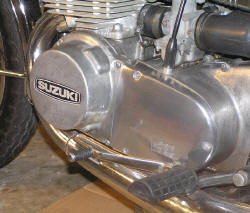
I polished the sprocket cover, compare
with the mag cover. |
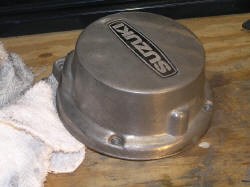
Mag cover before |
_small.jpg)
Many years of exposure to the elements
makes aluminum oxidize (rust). |
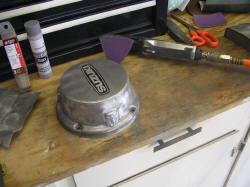
After some time with the multi-tool
using 220 paper. |
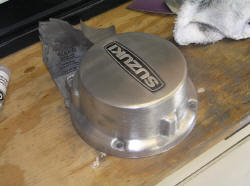
After 400 paper. |
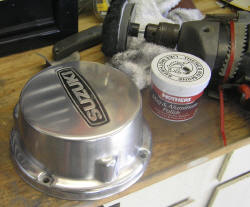
After 600 and 1200, then buffing with Mother's polish |
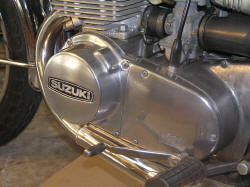
Solid improvement |
|
May 2012:
Replacing the gauge glass
July 2012 - Inspection time
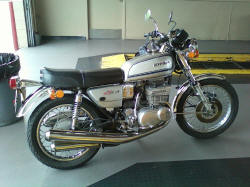
Nov 2012:
Replacing fork seals
|
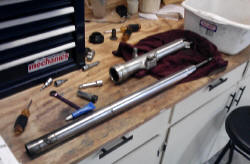
With riding weather quickly going away, I thought to do some maintenance.
The fork seals have been leaking a while now, and I have done fork seals
before on a couple of bikes. |
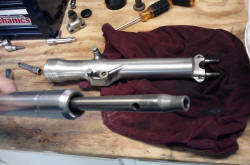
My 1975 380 has a clip on top of the seal, that came out pretty easily, but
getting the seals out is TOUGH! I read somewhere about immersing the seal in
boiling water...it softened the rubber but still couldn't get the seal out. |

I tried prying gently with a screwdriver and chewed up the seal, but it
stayed in place. |
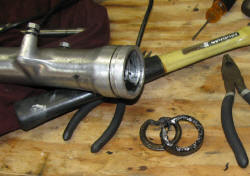
Success! A combination of a chisel, screwdriver and gently applied dremel
cuts. It was really stuck in there.
|
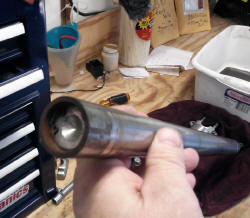
The top does not have the customary large fork cap that comes off with a
wrench; a circlip holds a bung in place. Some penetrating lube and
persistent taps with a socket and hammer and it came out. It is under a
little pressure, so keep a glove over it to prevent it flying into space. |
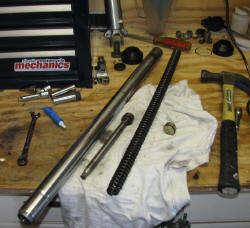
All apart. |
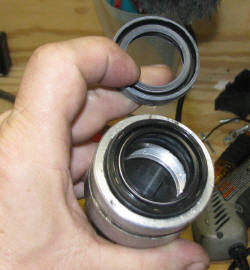
The seal is in the fork leg correctly--the opposite is being held for
display. |
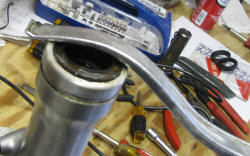
Not wanting to dare the dremel again, I searched the toolbox and found
this--a seal remover! Actually, it's a tire iron but it worked perfectly.
Just take it easy on the pressure, pry a little at a time, don't fracture
the fork tube. |
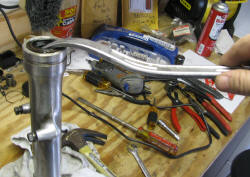
Yes, it eases the seal up. Of course, once the seal gets flush with the
foruk tube, the tire iron pushes it back down on the near side, so to get
the seal fully out,... |
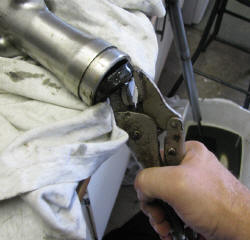
...I used vice-grips and the edge of the workbench for leverage, and worked
it on out. |
|
|
Return to
The MOTO-DUDE DOMAIN
Last revved up:
11/15/2012
























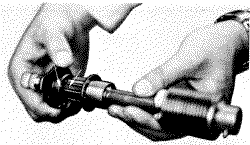

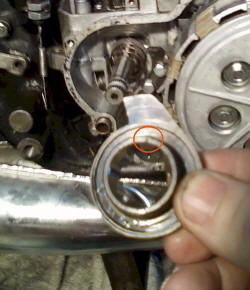
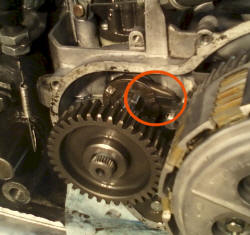







_small.jpg)
